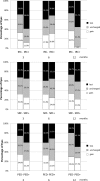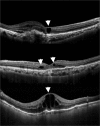Biomarkers of optical coherence tomography in evaluating the treatment outcomes of neovascular age-related macular degeneration: a real-world study
- PMID: 30679743
- PMCID: PMC6345958
- DOI: 10.1038/s41598-018-36704-6
Biomarkers of optical coherence tomography in evaluating the treatment outcomes of neovascular age-related macular degeneration: a real-world study
Abstract
This study evaluated the characteristic changes in optical coherence tomography (OCT) biomarkers in neovascular age-related macular degeneration (nAMD) treated with anti-vascular endothelial growth factor drugs and their relationship with visual outcomes at 1-year follow-up in a real-world setting. We retrospectively reviewed the medical records of 126 eyes with nAMD treated with either intravitreal ranibizumab or aflibercept, including ophthalmologic examinations and spectral-domain OCT at baseline and months 3, 6, and 12 after first injection. Treatment response of intraretinal cysts (IRCs), subretinal fluid (SRF), and pigment epithelial detachment (PED), and the correlation between best-corrected visual acuity (BCVA) changes and these OCT biomarkers were analyzed. After an average of 5.1 ± 1.5 injections, 33.3% of eyes with PED showed resolution at month 12, a significantly lower proportion than for IRCs (53.8%) or SRF (51.6%). BCVA improvement at 1 year was negatively associated with PED at baseline and with IRCs or PED at month 12. Persistence of IRCs at month 12 was associated with degeneration morphology of IRCs at baseline and non-resolved cysts at month 3 after loading. In conclusions, IRCs and PED are associated with poor visual improvement in nAMD in a real-world setting. Both IRCs and SRF responded better than PED to anti-VEGF therapy.
Conflict of interest statement
The authors declare no competing interests.
Figures





References
MeSH terms
Substances
LinkOut - more resources
Full Text Sources
Medical
Miscellaneous

